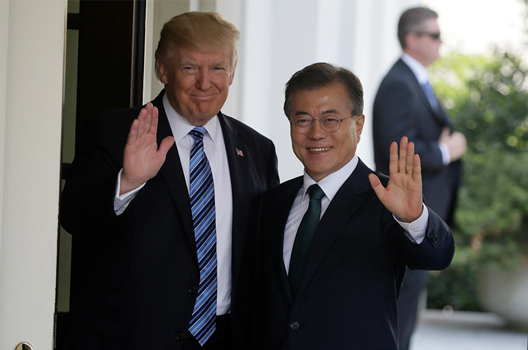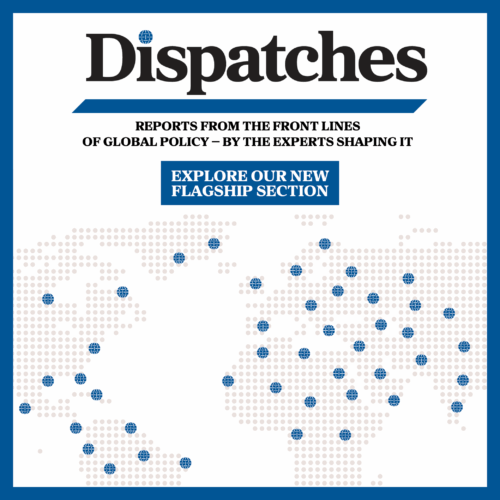
Why I’ve grown more optimistic that we have the chance to repair history’s bloodiest remaining divide.
Jet lag can play tricks on the mind.
Lying wide awake at just past three in the morning, some thirteen hours ahead of DC time in South Korea, I grow convinced we are within reach of the chance of the century to repair history’s bloodiest remaining divide. At the end of a week’s fact-gathering in Seoul, it’s hard to know whether this is rational thinking or nocturnal delusion.
Whichever it turns out to be, a Hollywood script writer could not have framed the plot nor provided its protagonists more inventively.
At center stage stand two flawed heroes as unlikely peace partners: US President Donald J. Trump, age seventy-one, reviled by his enemies, who are calling for his impeachment, as a narcissist; and North Korean dictator Kim Jong-un, believed to be thirty-five, thought to have executed his uncle and assassinated his half-brother, whose focus until recently has been rapid development of nuclear, cyber, and conventional weapons.
Their self-appointed matchmaker, South Korean President Moon Jae-in, age sixty-four, strikes even his allies as perhaps a little too principled, soft spoken, and polite for this role. The Atlantic Council last September honored President Moon, himself the son of North Korean refugees, with its Global Citizen Award, recognizing a life that went from student imprisonment as a protestor to his stunning, anti-corruption electoral victory in 2017.
Yet not even we could have imagined how quickly he would face the opportunity to achieve his life’s dream of peace on the Korean peninsula. As he arrives in Washington this week to help prepare President Trump for his June 12 summit with North Korea’s leader, insiders say he may spend less time on the potential deal’s nuts and bolts (a task more for staffs) and put more effort into coaching the US deal-maker-in-chief on how to navigate the North Korean over the finish line.
In the view of senior South Korean officials, this extraordinary mix of personalities presents more of an opportunity than an obstacle to a deal. What all three share is a deep-seated desire to reach an agreement. Kim needs the US guarantee not to engage in regime change and the easing of economic sanctions to modernize and open his country. President Trump wants to counter his enemies, cement his legacy and win his Nobel Peace Prize. Moon is grasping for a once-in-a-lifetime opportunity at peace that may not return for decades should this chance pass.
Lurking in the background as a potential spoiler or helper in this drama is Chinese leader Xi Jinping, who sees both opportunity and peril. The right sort of peace deal could weaken the US alliance with South Korea, reduce the threat of conflict and refugee flows on Chinese borders, and ultimately lead to the withdrawal of US troops from South Korea. Conversely, if Trump navigates too well China could be confronted with a stronger, larger, and ultimately reunified Korea as a regional, democratic bulwark and US ally.
Any best-case outcome will require methodical preparation for June 12. The experts will have to work on the daunting details and painstaking sequencing of denuclearization, diplomatic normalization, and sanctions relief in a manner that incentivizes North Korea and achieves the US goal of “permanent, verifiable, and irreversible denuclearization.”
Getting North Korea’s leader to swallow that will require the United States and its allies to convince him, if he isn’t already, that holding onto his nuclear capability will do more to endanger his regime’s survival than to ensure it. That will require permanently reversing his logic until now that it was only a fully developed nuclear capability that could protect him from a Libyan-like demise.
Yet South Korean officials believe that an-all sticks approach will backfire, either because Kim will walk away from the table or military hardliners at home may compel him to do so. The time may be right for some carrots, answering North Korea’s unconditional release of three US prisoners and dismantling its nuclear test site with some similar gestures, perhaps involving the freeing up of United Nations (UN) humanitarian support or other such moves.
President Moon may want to offer President Trump the chance to study the most important possible “game film” ahead of the Singapore summit, and that is the video from his own interactions with Kim during their April 27 meeting at Panmunjom, where the two Korean leaders achieved history-with their steps, hand in hand, across the world’s most heavily armed border. What Trump will see is a steady, calm, friendly and humble South Korean leader, who through his gestures showers Kim with respect and dignity as an equal leader.
At first blush, it would seem the dramatic personality differences between Moon and Trump would defy any similar approach. Yet no one knows better than President Trump how to turn on the charm when on the hunt for a deal. South Koreans who have dealt with Kim believe in Singapore Trump will achieve more through a calm wooing than bullying. The gestures that could make a tough deal easier to swallow could be as simple as opening a door for the North Korean leader or pouring him a cup of tea.
South Korean leaders considered it a good sign this week that President Trump responded as he did to North Korea’s cancelling of its talks with South Korea and to a key government official’s tough statement that threatened to pull down the June 12 summit, attacking US National Security Advisor John Bolton as repugnant for his suggestion that North Korea’s denuclearization would follow the Libyan model, which to Kim suggested deposition and death.
Asked by media for his response, Trump repeated in several ways that nothing really had changed and the summit was still on track. Regarding Bolton, he said, “The Libyan model is not a model that we have at all when we are thinking of North Korea.” Trump in deal mode may just be able to pull off his own customized version of President Moon’s Panmunjom performance. It is not hard to imagine a set of circumstances that could provide a deal, perhaps even one that could over time transform the Korean Peninsula into a nuclear-free zone of peace and prosperity.
Having witnessed the peaceful unification of Germany and the Cold War’s end at a time when virtually no one had anticipated it, while a nuclear-armed Soviet Union imploded, I leave South Korea with an overwhelming sense that another great historic moment may present itself.
Or perhaps I’m just dreaming.
If this all goes tragically wrong, blame the jet lag.
Frederick Kempe is president and chief executive officer of the Atlantic Council. You can follow him on Twitter @FredKempe. This blog post is based on his weekly InflectionPoints newsletter. Read the newsletter in full here.
Image: US President Donald Trump (L) welcomes South Korean President Moon Jae-in at the White House in Washington, DC, US, June 30, 2017. (REUTERS/Jim Bourg)

